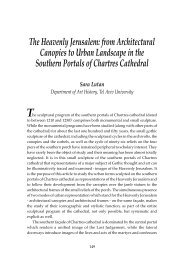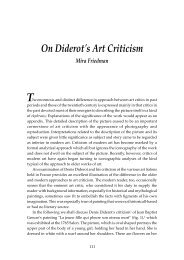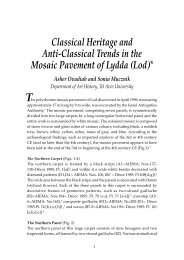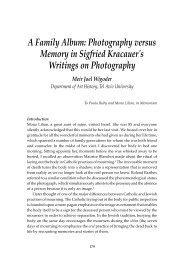The Non-presence of People in David Hockney's Paintings of ...
The Non-presence of People in David Hockney's Paintings of ...
The Non-presence of People in David Hockney's Paintings of ...
Create successful ePaper yourself
Turn your PDF publications into a flip-book with our unique Google optimized e-Paper software.
THE NON-PRESENCE OF PEOPLE IN DAVID HOCKNEY'S PAINTINGS<br />
<strong>The</strong> <strong>Non</strong>-<strong>presence</strong> <strong>of</strong> <strong>People</strong> <strong>in</strong><br />
<strong>David</strong> <strong>Hockney's</strong> Pa<strong>in</strong>t<strong>in</strong>gs <strong>of</strong><br />
Nouveau Riche Houses<br />
Revital Grün Silverman<br />
Tel Aviv University<br />
<strong>The</strong> house, the residence, is the only rampart aga<strong>in</strong>st the dread <strong>of</strong><br />
noth<strong>in</strong>gness, darkness and the obscurity <strong>of</strong> the past… Man’s<br />
identity is thus residential… <strong>The</strong> man without a home is a potential<br />
crim<strong>in</strong>al<br />
Immanuel Kant 1<br />
In this article I would like to discuss two forms <strong>of</strong> spaces <strong>of</strong> <strong>Hockney's</strong><br />
nouveau-riche’s series: on the one hand, the space <strong>of</strong> pa<strong>in</strong>t<strong>in</strong>g – the space <strong>in</strong>side<br />
the <strong>in</strong>ner frame and the space between the <strong>in</strong>ner and external frame; and on<br />
the other hand, the space <strong>of</strong> the nouveau-riche house that is divided <strong>in</strong>to two<br />
k<strong>in</strong>ds - those that are entirely devoid <strong>of</strong> people and those that feature a<br />
presentation <strong>of</strong> the collectors. In this article I discuss the perception <strong>of</strong> space <strong>in</strong><br />
the “empty” houses, through two prom<strong>in</strong>ent works from the series: A Bigger<br />
Splash (Fig. 1) and A Lawn Spr<strong>in</strong>kler (Fig. 2). Although it is widely accepted,<br />
that the collectors are not present <strong>in</strong> the works, I argue that even when they are<br />
not explicitly represented there is a trace <strong>of</strong> the collectors.<br />
<strong>The</strong> theme <strong>of</strong> nouveau-riche houses has occupied <strong>David</strong> Hockney s<strong>in</strong>ce the<br />
sixties, a short time after his move from northern England to California, <strong>in</strong><br />
1964. Hockney escorted the art dealer John Kasm<strong>in</strong>, to a series <strong>of</strong> bus<strong>in</strong>ess<br />
meet<strong>in</strong>gs <strong>in</strong> various art collectors’ homes, <strong>in</strong> the suburbs <strong>of</strong> Los Angeles.<br />
Through these meet<strong>in</strong>gs he learned to know those houses. As a foreigner,<br />
Hockney created an eccentric and unique image <strong>of</strong> his adopted home; a theme<br />
that made its debut <strong>in</strong> the sixties, when he began to pa<strong>in</strong>t the suburbs <strong>of</strong> Los<br />
Angeles, organiz<strong>in</strong>g them as a pla<strong>in</strong> accord<strong>in</strong>g to a geometrical, straight and<br />
rigorous pattern. 2<br />
103
REVITAL SILVERMAN<br />
Fig. 1: <strong>David</strong> Hockney, A Bigger Splash, 1967. Acrylic on canvas, 244x244,<br />
Marchioness <strong>of</strong> Duffer<strong>in</strong> and Ava, London.<br />
<strong>The</strong> housepipe <strong>in</strong> A Lawn Spr<strong>in</strong>kler and the stepp<strong>in</strong>g stone <strong>in</strong> A Bigger Splash,<br />
<strong>in</strong>troduces the spectator <strong>in</strong>to the depth <strong>of</strong> the picture. Any feel<strong>in</strong>g <strong>of</strong> depth<br />
disappears because the lawn <strong>in</strong> the front and back plane is treated with the<br />
same <strong>in</strong>tensity. <strong>The</strong>re is no blurr<strong>in</strong>g <strong>of</strong> color <strong>in</strong> the distance; no depth <strong>in</strong> the<br />
depiction <strong>of</strong> water. <strong>The</strong> water and the splash belong to the same reality but are<br />
depicted as different ones; no shadow exists, except that <strong>of</strong> the chair <strong>in</strong> A Bigger<br />
Splash. <strong>The</strong> pa<strong>in</strong>ted frame, <strong>in</strong> both pictures, creates the awareness to the twodimensionality<br />
<strong>of</strong> the canvas.<br />
<strong>The</strong>se pa<strong>in</strong>t<strong>in</strong>gs are among the last <strong>in</strong> which Hockney used a frame around<br />
the image - whether pa<strong>in</strong>ted or left as bare marg<strong>in</strong>s <strong>of</strong> canvas - which is the<br />
space between the <strong>in</strong>ner and external frame. Hockney expla<strong>in</strong>s the white stripe:<br />
104
THE NON-PRESENCE OF PEOPLE IN DAVID HOCKNEY'S PAINTINGS<br />
Fig. 2: <strong>David</strong> Hockney, A Lawn Spr<strong>in</strong>kler, 1967. Acrylic on canvas, 122x122,<br />
Collection <strong>of</strong> Mr. and Mrs. J. G. Studholme, London.<br />
‘I used borders around an image a lot, from about 1964 to 1967. This wasn’t<br />
just a fram<strong>in</strong>g device. It started <strong>of</strong>f as a formal device… it seemed to me that if<br />
I cut that picture <strong>of</strong>f there, it became more conventional, and I was a little<br />
frightened <strong>of</strong> that then’. 3 Both works comprise a flat square with white borders<br />
that emphasize the flatness <strong>of</strong> the canvas itself - the two-dimensionality that is<br />
so <strong>in</strong>dispensable to modern pa<strong>in</strong>t<strong>in</strong>g, as it is to Polaroid photography.<br />
<strong>The</strong> white strip can be related to the space between two borders, the way<br />
that Samuel Weber describes the symbolic structure <strong>of</strong> psychic anxiety itself:<br />
‘Anxiety is perhaps what one feels when the world reveals itself to be caught<br />
up <strong>in</strong> the space between two frames: a doubled frame, or one that is split’. 4<br />
This <strong>in</strong>-between space, a third space, is the place where th<strong>in</strong>gs are not connected;<br />
105
REVITAL SILVERMAN<br />
it is not just between borders but it is the place itself that is not self-evident,<br />
that causes anxiety, because the object fac<strong>in</strong>g one is not clear. whereas Weber’s<br />
theory belongs to the psychoanalytic discourse, the follow<strong>in</strong>g theories, that I<br />
shall develop here belong to the sociological and the philosophical discourse.<br />
In Frame Analysis 5 by the American sociologist Erv<strong>in</strong>g G<strong>of</strong>fman, there is a<br />
dist<strong>in</strong>ction between two broad classes <strong>of</strong> primary frameworks: natural and<br />
social. Nathalie He<strong>in</strong>ich applies this theory to the bullfight <strong>in</strong> her article<br />
“Fram<strong>in</strong>g the bullfight: Aesthetics versus ethics”, 6 as an example <strong>of</strong> the social<br />
and the transformed frame: In opposition to the “savage” un<strong>in</strong>tended and<br />
unformalized confrontation <strong>of</strong> a bull and a man <strong>in</strong> a field, which would<br />
constitute a primary frame, there exists the social as the transformed frame.<br />
<strong>The</strong> key (<strong>of</strong> performance) and the fabrication (formal, regulated ceremony) are<br />
two types <strong>of</strong> transformed frame. He<strong>in</strong>ich claims that transformed frames are<br />
characterized by the existence <strong>of</strong> brackets. This spatial brackets delimit several<br />
levels <strong>of</strong> participation: the walls <strong>of</strong> the arena isolate, all the participants<br />
(transformed frame) from the external world (primary frame). <strong>The</strong> first barrier<br />
isolates from the public all the personnel (actors, doctors, etc.); the second barrier<br />
isolates, from the alley between those two barriers reserved for the personnel,<br />
the team made up by the matadors and toreadors, picadors and horses,<br />
banderilleros and <strong>of</strong> course, the bull..I claim that as Hockey’s frame, ‘<strong>The</strong>se<br />
brackets’, <strong>in</strong> He<strong>in</strong>ich words, ‘which are neither <strong>in</strong>side, nor outside, like the<br />
frame <strong>of</strong> a picture, become part <strong>of</strong> an action as soon as an actor transgresses it,<br />
when <strong>in</strong> flee<strong>in</strong>g or <strong>in</strong> pursuit outside the arena’. 7<br />
Two philosophers have followed the changes <strong>in</strong> the status <strong>of</strong> the frame<br />
(Immanuel Kant and Jacques Derrida). Kant considers the necessary conditions<br />
for someth<strong>in</strong>g to be beautiful:<br />
Even that we call “ornaments” [parerga], those th<strong>in</strong>gs which do<br />
not belong to the complete representation <strong>of</strong> the object <strong>in</strong>ternally<br />
as elements, but only externally as complements, and which<br />
augment the satisfaction <strong>of</strong> taste, do not only by their forms; as,<br />
for example the frames <strong>of</strong> pictures or the draperies <strong>of</strong> statues or<br />
the colonnades <strong>of</strong> places. But if the ornament does not itself consist<br />
<strong>in</strong> beautiful form and if it is used as a golden frame is used, merely<br />
to recommend the pa<strong>in</strong>t<strong>in</strong>g by its charm, it is then called f<strong>in</strong>ery<br />
and <strong>in</strong>jures genu<strong>in</strong>e beauty. 8<br />
Frames have no value as themselves, accord<strong>in</strong>g Kant, but are <strong>in</strong>tended to draw<br />
attention to the creation itself, to be supplements. As such, claims Jacques<br />
106
THE NON-PRESENCE OF PEOPLE IN DAVID HOCKNEY'S PAINTINGS<br />
Derrida <strong>in</strong> <strong>The</strong> truth on pa<strong>in</strong>t<strong>in</strong>g, <strong>in</strong> the section that deals with Kant: ‘You have<br />
to know what <strong>in</strong>tr<strong>in</strong>sically concerns the value “beauty” and what rema<strong>in</strong>s<br />
external to your immanent sense <strong>of</strong> beauty. This requirement presupposes a<br />
discourse on the limit between the <strong>in</strong>side and outside <strong>of</strong> the art object, here a<br />
discourse on the frame’. 9 <strong>The</strong>se ornaments, cont<strong>in</strong>ues Derrida, work for Kant<br />
as <strong>in</strong>ner and outer borders. <strong>The</strong>y act as supplements - they are outside, but<br />
they are not the th<strong>in</strong>gs that are outside, because they are the borders. However,<br />
the supplement has a potential for greater importance than the work itself,<br />
s<strong>in</strong>ce without it one would not know where the creation beg<strong>in</strong>s and ends, or<br />
even the fact that one is stand<strong>in</strong>g <strong>in</strong> front <strong>of</strong> a creation.<br />
In addition to the problem <strong>of</strong> the absence <strong>of</strong> depth <strong>in</strong> the picture, discussed<br />
above, the disappearance <strong>of</strong> the body is another question that arises from those<br />
pa<strong>in</strong>t<strong>in</strong>gs. Both the water and the glass act as screens that conceal the human<br />
body: the bodies <strong>of</strong> the collectors <strong>in</strong> A Lawn Spr<strong>in</strong>kler, and the body <strong>of</strong> the diver<br />
<strong>in</strong> A Bigger Splash. In the former, the glass w<strong>in</strong>dow is simultaneously transparent<br />
- it is possible to see the armchair and other furniture <strong>in</strong>side the house, and<br />
opaque-mirror<strong>in</strong>g the outside view.<br />
Rosal<strong>in</strong>d Krauss notes that a grid [<strong>in</strong> our case the bars over the w<strong>in</strong>dows]<br />
conveys one <strong>of</strong> the basic laws <strong>of</strong> knowledge - separation <strong>of</strong> the perceptual screen<br />
from that <strong>of</strong> the “real” world. 10 <strong>The</strong> w<strong>in</strong>dow, she cont<strong>in</strong>ues, is experienced as<br />
simultaneously transparent and opaque. As a transparent vehicle, it is that<br />
which admits light - or spirit - <strong>in</strong>to the <strong>in</strong>itial darkness <strong>of</strong> the room. But if glass<br />
transmits, it also reflects. And so the w<strong>in</strong>dow is experienced as a mirror -<br />
someth<strong>in</strong>g that freezes and locks the self <strong>in</strong>to the space <strong>of</strong> its own reduplicated<br />
be<strong>in</strong>g; the bars <strong>of</strong> the w<strong>in</strong>dow - the grid - are what help us to see, to focus.<br />
Lefebvre cont<strong>in</strong>ues this l<strong>in</strong>e <strong>of</strong> thought when he speaks <strong>of</strong> a ‘double<br />
illusion’, 11 each side <strong>of</strong> which refers back to the other, re<strong>in</strong>forces the other, and<br />
hides beh<strong>in</strong>d the other. <strong>The</strong> two aspects are the illusion <strong>of</strong> transparency on the<br />
one hand and the illusion <strong>of</strong> opacity, or “realistic” illusion, on the other. In the<br />
illusion <strong>of</strong> transparency, he claims, space appears as lum<strong>in</strong>ous, as <strong>in</strong>telligible,<br />
as giv<strong>in</strong>g free re<strong>in</strong> for action. <strong>The</strong> realistic illusion is closer to (naturalistic and<br />
mechanistic) materialism. Rather than be<strong>in</strong>g mutually antagonistic, each illusion<br />
embodies and nourishes the other. <strong>The</strong> oscillation between the two, and the<br />
result<strong>in</strong>g flicker<strong>in</strong>g effect, are thus just as important as either <strong>of</strong> the illusions<br />
considered <strong>in</strong> isolation.<br />
Krauss’ argument discussed above relates also to the idea <strong>of</strong> public and<br />
private space: the 20 th century has been witness to the build<strong>in</strong>g <strong>of</strong> such private<br />
homes as “Prairie House” (1900), designed by Frank Lloyd Wright and<br />
107
REVITAL SILVERMAN<br />
published <strong>in</strong> the Ladies’ Home Journal. 12 As the ideal design <strong>of</strong> a house suggest<strong>in</strong>g<br />
absolute privacy, the w<strong>in</strong>dow open<strong>in</strong>gs fac<strong>in</strong>g the street are relatively small,<br />
and are located high up, under the eaves. In contrast, “Farnsworth House”<br />
(1946-51), Ill<strong>in</strong>ois, designed by Ludwig Mies van der Rohe, <strong>of</strong>fers the opposite<br />
approach, which Elizabeth Gordon describes as ‘a one room house that is<br />
noth<strong>in</strong>g but a glass cage on stilts’. ❩❭ Gordon perceives this house as a home that<br />
can not be shielded from the public gaze. Edith Farnsworth, owner <strong>of</strong> the house,<br />
herself noted, ‘the house is transparent, like an X-ray’. 14<br />
<strong>The</strong> well-groomed facades <strong>of</strong> the collector’s houses that Hockney depicts<br />
require us to keep a distance, while the large glass w<strong>in</strong>dows and the pool,<br />
which are situated outdoors, prevent an image <strong>of</strong> absolute privacy. Mike Davies<br />
observes that ‘security has less to do with personal safety than with the degree<br />
<strong>of</strong> personal <strong>in</strong>sulation’. 15<br />
In A Bigger Splash another problem arises: that <strong>of</strong> space <strong>in</strong> time; or, <strong>in</strong> other<br />
words, the freez<strong>in</strong>g <strong>of</strong> time that <strong>David</strong> Hockey recounts:<br />
I loved the idea <strong>of</strong> pa<strong>in</strong>t<strong>in</strong>g this th<strong>in</strong>g that lasts for two seconds, it<br />
takes me two weeks to pa<strong>in</strong>t this event that lasts for two seconds.<br />
<strong>The</strong> effect <strong>of</strong> it as it got bigger was more stunn<strong>in</strong>g - everybody<br />
knows a splash can’t be frozen <strong>in</strong> time, it doesn’t exist, so when<br />
you see it like that <strong>in</strong> a pa<strong>in</strong>t<strong>in</strong>g it’s even more strik<strong>in</strong>g than <strong>in</strong> a<br />
photograph, because you know a photograph took a second to<br />
take, or less. In fact if it’s a splash and there’s no blur <strong>in</strong> it, you<br />
know it took a sixtieth <strong>of</strong> a second, less time than the splash existed<br />
for. <strong>The</strong> pa<strong>in</strong>t<strong>in</strong>g took much longer to make than the splash existed<br />
for, so it has a very different effect on the viewer. When the pa<strong>in</strong>t<strong>in</strong>g<br />
was exhibited <strong>in</strong> Paris <strong>in</strong> 1974, I had them po<strong>in</strong>t one <strong>of</strong> the lights<br />
right on the splash itself, so it was even whiter. 16<br />
Hockney froze the moment <strong>of</strong> the splash. 17 It is visible as a trace <strong>of</strong> the unseen<br />
diver. <strong>The</strong> trace has no <strong>presence</strong>, notes Derrida. Like a signifier, it refers to<br />
someth<strong>in</strong>g that is absent, and the gap between traces refers to someth<strong>in</strong>g that<br />
is miss<strong>in</strong>g provid<strong>in</strong>g a sense <strong>of</strong> ‘essence’. Accord<strong>in</strong>g to Vasseleu, Irigaray, writ<strong>in</strong>g<br />
on this suspension; mentions the ‘forgotten vag<strong>in</strong>a’, when she places a different<br />
emphasis on the ‘detour/passage’ <strong>of</strong> metaphor by relat<strong>in</strong>g it to the passage<br />
between the artificially lit <strong>in</strong>terior and the purity <strong>of</strong> the outside light, <strong>in</strong> Plato’s<br />
famous cave allegory. Irigaray contends that it is precisely the metaphoric<br />
omission <strong>of</strong> the transition that allows such movement. <strong>The</strong> ‘forgotten vag<strong>in</strong>a’<br />
108
THE NON-PRESENCE OF PEOPLE IN DAVID HOCKNEY'S PAINTINGS<br />
is the ‘passage that is miss<strong>in</strong>g, left on the shelf, between the outside and the<br />
<strong>in</strong>side, between the plus and the m<strong>in</strong>us’. 18<br />
Irigaray names ‘<strong>in</strong>scriptional space’, 19 accord<strong>in</strong>g to Judith Butler, as the<br />
specular surface that receives the marks <strong>of</strong> a mascul<strong>in</strong>e signify<strong>in</strong>g act only to<br />
give back a (false) reflection and guarantee <strong>of</strong> phallogocentric self-sufficiency,<br />
without mak<strong>in</strong>g any contribution <strong>of</strong> its own. This <strong>in</strong>scriptional space makes its<br />
appearance <strong>in</strong> Plato’s “Timaeus” as the receptacle (Khora). This receptacle is<br />
not a metaphor based on likeness to a human form, but a disfiguration that<br />
emerges at the boundaries <strong>of</strong> the human, both as its very condition and as the<br />
<strong>in</strong>sistent threat <strong>of</strong> its deformation. It cannot take a form, a morphe and, <strong>in</strong> that<br />
sense it cannot be a body.<br />
Derrida sees this <strong>in</strong>scriptional space as a third gender/genre that cannot<br />
(she/it) be called by name. He expla<strong>in</strong>s that there is a preference for the <strong>presence</strong><br />
<strong>of</strong> speech over writ<strong>in</strong>g. Speech represents essence, orig<strong>in</strong>, it arrives without<br />
mediation and is exact, true and correct; whereas writ<strong>in</strong>g conta<strong>in</strong>s tears, cracks<br />
and voids. In <strong>in</strong>scription there is a process <strong>of</strong> <strong>in</strong>citement, movement, removal<br />
<strong>of</strong> the basic categories, through which we deliver <strong>in</strong>formation: ‘<strong>The</strong> problematic<br />
<strong>of</strong> the place - the third irreducible class - all these th<strong>in</strong>gs “require” that we<br />
def<strong>in</strong>e the orig<strong>in</strong> <strong>of</strong> the world as trace, that is, a receptacle. It is a matrix, womb,<br />
or receptacle that is never and nowhere <strong>of</strong>fered up <strong>in</strong> the form <strong>of</strong> <strong>presence</strong>...’. 20<br />
<strong>The</strong> terms ‘receptacle’, ‘matrix’, ‘mother’, ‘nurse’, cause us to th<strong>in</strong>k <strong>of</strong> a space<br />
that conta<strong>in</strong>s th<strong>in</strong>gs. <strong>The</strong> vag<strong>in</strong>al absence space implies that the place is a<br />
fem<strong>in</strong><strong>in</strong>e place. Khora is a place, a hole, a puncture, receptacle, womb. <strong>The</strong><br />
womb has no quality <strong>of</strong> its own, it is empty, a miss<strong>in</strong>g <strong>presence</strong>, the ‘différance’,<br />
suspension, space; it accepts, but owns noth<strong>in</strong>g.<br />
<strong>The</strong> water <strong>in</strong> Hockey’ pa<strong>in</strong>t<strong>in</strong>gs is a screen that represents the body that can<br />
not be achieved. <strong>The</strong> diver is not seen, and the splash emphasizes what Merleau-<br />
Ponty calls ‘<strong>The</strong> scandal <strong>of</strong> depth’, i.e., the capacity <strong>of</strong> depth to hide th<strong>in</strong>gs<br />
from us, to swallow them up. 21 He claims that the picture is a flat th<strong>in</strong>g,<br />
contriv<strong>in</strong>g to give us what we would see <strong>in</strong> the <strong>presence</strong> <strong>of</strong> th<strong>in</strong>gs by <strong>of</strong>fer<strong>in</strong>g<br />
sufficient diacritical signs, through height and width, <strong>of</strong> the miss<strong>in</strong>g<br />
dimension. 22 Depth is a third dimension derived from the other two. Th<strong>in</strong>gs<br />
encroach upon one another because they are outside one another accord<strong>in</strong>g<br />
Merleoq-Ponf. <strong>The</strong> pro<strong>of</strong> <strong>of</strong> this is that one can see depth <strong>in</strong> a pa<strong>in</strong>t<strong>in</strong>g, which<br />
everyone agrees has none and which organizes <strong>in</strong>to an illusion <strong>of</strong> an illusion.<br />
<strong>The</strong> Silueta Works by Ana Mendieta (Fig. 4), and the Portrait <strong>of</strong> the Gardener<br />
Vallier by Paul Cézanne (Fig. 3), I want to argue, are another example <strong>of</strong> the<br />
suspension that exists between real and illusionary space. In the portrait by<br />
109
REVITAL SILVERMAN<br />
Fig. 3: Paul Cézanne, Portrait <strong>of</strong> Gardner Vallier, 1906. Graphite and<br />
watercolor on paper, 48x31.5, the Berggruer Collection, on loan to<br />
the National Gallery, London.<br />
110
THE NON-PRESENCE OF PEOPLE IN DAVID HOCKNEY'S PAINTINGS<br />
Fig. 4: Ana Mendieta, Silueta Works <strong>in</strong> Iowa, 1976-78, color photograph,<br />
50.8x40.6, edition <strong>of</strong> 20. <strong>The</strong> Estate <strong>of</strong> Ana Mendieta and Galerie<br />
Lelong, New York.<br />
Cézanne, the blank spaces <strong>of</strong> a white page are not filled but surrounded by<br />
colours that signify the white beard and clothes <strong>of</strong> the gardener Vallier, and<br />
that take on the function <strong>of</strong> giv<strong>in</strong>g shape and sett<strong>in</strong>g it <strong>of</strong>f. Relat<strong>in</strong>g to the<br />
watercolors <strong>of</strong> the late years <strong>of</strong> Cézanne, Ponty notes, ‘space radiates around<br />
planes that cannot be assigned any place at all’. 23 Mendieta’s photographs<br />
function as documentation <strong>of</strong> her impressed body, testify<strong>in</strong>g that ‘Mendieta<br />
was there’, 24 while also record<strong>in</strong>g her total absence - they are but traces <strong>of</strong> traces,<br />
traces that evoke a strong sense <strong>of</strong> isolation, aloneness and lonel<strong>in</strong>ess.<br />
<strong>The</strong> splash <strong>in</strong> Hockney’s A Bigger Splash is the diver’s trace; it functions like<br />
the white left by Cézanne is the gardener’s body trace and Mendieta’s<br />
photographs are the traces <strong>of</strong> her body. In all three works the issue <strong>of</strong> orig<strong>in</strong>s<br />
becomes one <strong>of</strong> how - if at all- they can be commemoratively recalled. If,<br />
accord<strong>in</strong>g Derrida, ‘Everyth<strong>in</strong>g beg<strong>in</strong>s by referr<strong>in</strong>g back, that is to say, does<br />
not beg<strong>in</strong>’, everyth<strong>in</strong>g is <strong>in</strong> effect a memory trace; but <strong>of</strong> what, asks Edward S.<br />
Casey, if not <strong>of</strong> a beg<strong>in</strong>n<strong>in</strong>g then <strong>of</strong> an (absent) orig<strong>in</strong>? 25 Everyth<strong>in</strong>g beg<strong>in</strong>s by<br />
forgett<strong>in</strong>g the orig<strong>in</strong>: ‘<strong>The</strong> beg<strong>in</strong>n<strong>in</strong>g <strong>of</strong> Western thought’ accord<strong>in</strong>g Heidegger,<br />
‘is not the same as its orig<strong>in</strong>. <strong>The</strong> beg<strong>in</strong>n<strong>in</strong>g is, rather, the veil that conceals the<br />
111
REVITAL SILVERMAN<br />
orig<strong>in</strong> – <strong>in</strong>deed an unavoidable veil… <strong>The</strong> orig<strong>in</strong> keeps itself concealed <strong>in</strong> the<br />
beg<strong>in</strong>n<strong>in</strong>g’. 26<br />
<strong>The</strong> above discussed image <strong>of</strong> people <strong>in</strong> Hockney’s work, from full <strong>presence</strong><br />
till total disappearance, rem<strong>in</strong>ds us (as do the solitary figures <strong>in</strong> Cézanne’s<br />
and Mendieta’s works) Heidegger’s notion <strong>of</strong> Presence that is not itself<br />
someth<strong>in</strong>g <strong>in</strong> the present but rather 'the wholeness <strong>of</strong> life, achieved only <strong>in</strong><br />
death, when we are no longer ‘there’. 27 It is thus, <strong>in</strong> the words <strong>of</strong> Susan Best,<br />
‘not through our <strong>presence</strong>, but through our pass<strong>in</strong>g, that we are f<strong>in</strong>ally<br />
<strong>in</strong>dividuated and complete’. 28<br />
<strong>The</strong> art collectors and the diver, though not seen, are like the white stripe -<br />
the frame; they are present <strong>in</strong> another space, a third space, a twilight zone, a<br />
place <strong>in</strong> between; a space that is made possible by the lack <strong>of</strong> acceptance <strong>of</strong><br />
b<strong>in</strong>arity; a place where th<strong>in</strong>gs are disconnected and are not self-evident.<br />
Notes<br />
1. Edelman 1984: 25-26 (quoted <strong>in</strong> Terence Riley1999:9).<br />
2. Hockney returned to this theme <strong>in</strong> the eighties, but now to panoramic images <strong>of</strong><br />
houses whose access is by narrow serpent<strong>in</strong>e roads, based upon the drive from his<br />
house <strong>in</strong> Hollywood Hills to his studio <strong>in</strong> Santa Monica. In this article I refer to the<br />
earlier pa<strong>in</strong>t<strong>in</strong>gs only.<br />
3. Hockney 1976:125.<br />
4. Weber 1991: 167.<br />
5. G<strong>of</strong>fman 1974:21-22.<br />
6. He<strong>in</strong>ich 1993: 52-58.<br />
7. Ibid., p.54.<br />
8. Kant 1951: 61-62.<br />
9. Derrida 1987: 37-81.<br />
10. Krauss 1985: 15-17.<br />
11. Lefebvre 1991: 27-30.<br />
12. Wright 1901: p.17 (quoted <strong>in</strong> Riley 1999:14).<br />
13. Gordon 1953: 129.<br />
14. Barry 1953: 270 (quoted <strong>in</strong> Riley 1999: 15).<br />
15. Davies 1966: M.Davies “Fortress L.A”, <strong>in</strong>: <strong>The</strong> City Reader, London and New York<br />
1996 (1990): 159-160.<br />
16. Hockney 1976: 124-125.<br />
17. In opposition to the early works <strong>in</strong> which Hockney deals with frozen time; <strong>in</strong> later<br />
works he deals with pa<strong>in</strong>t<strong>in</strong>g landscapes on the road. <strong>The</strong> frozen splash can be<br />
related with Japanese pr<strong>in</strong>ts from the 19th century, for example: Beneath the Wave<br />
112
THE NON-PRESENCE OF PEOPLE IN DAVID HOCKNEY'S PAINTINGS<br />
Off Kavagawa, by Hokusai, known also as <strong>The</strong> Big Wave, is a decorative pr<strong>in</strong>t from<br />
the series <strong>of</strong> 36 views <strong>of</strong> Mount Fuji from the early 1830s.<br />
18. Vasseleu 1998: 3,8.<br />
19. Butler 1994: 152-154.<br />
20. Derrida 1981: 159-160.<br />
21. Sterckx 1999: 4.<br />
22. Merleau-Ponty 1993:121-149.<br />
23. Ibid.: 121.<br />
24. Best 1997: 92.<br />
25. Casey 1984: 607.<br />
26. Casey 1984: 607.<br />
27. Best 1997: 92.<br />
28. Best 1997: 92.<br />
List <strong>of</strong> References<br />
Barry 1953: J. A. Barry "Report on the American Battle between Good and Bad Modern<br />
Houses", House Beautiful 95 (1953).<br />
Best 1997: S. Best, (catalogue) “Just Look<strong>in</strong>g? <strong>The</strong> Body, the Gaze, and Syncope", Body,<br />
A. Bond (ed.), <strong>The</strong> art gallery <strong>of</strong> New south Wales, Australia, 1997.<br />
Butler 1994: J. Butler, “Bodies that matter”, C. Burke, N. Schor and M. Whitford (eds.),<br />
Engag<strong>in</strong>g with Irigaray, New York, 1994<br />
Casey 1984: E. S. Casey, “Orig<strong>in</strong>(s) <strong>in</strong> (<strong>of</strong>) Heidegger/Derrida”, <strong>The</strong> Journal <strong>of</strong> Philosophy,<br />
61, 10 (1984).<br />
Davies 1996: M. Davies, “Fortress L.A”, <strong>in</strong>: <strong>The</strong> City Reader, Routlidge, London and<br />
New York, 1996 (1990).<br />
Derrida 1981: J. Derrida, Dissem<strong>in</strong>ation, Chicago and London 1981.<br />
Derrida 1987: J. Derrida, <strong>The</strong> Truth <strong>in</strong> Pa<strong>in</strong>t<strong>in</strong>g, Chicago and London 1987.<br />
Edelman 1984: B. Edelman, La maison de Kant, Paris 1984.<br />
G<strong>of</strong>fman 1974: E. G<strong>of</strong>fman, Frame Analysis, New York 1974.<br />
Gordon 1953: E. Gordon, “<strong>The</strong> Threat to the Next America", House beautiful 95, 4 (1953).<br />
He<strong>in</strong>rich 1993: N. He<strong>in</strong>rich, “Fram<strong>in</strong>g the Bullfight: Aesthetics Versus Ethics”, <strong>The</strong> British<br />
Journal <strong>of</strong> Aesthetics, 33 (1993).<br />
Hockney1976: D.Hockney, <strong>David</strong> Hockney by <strong>David</strong> Hockney, London 1976.<br />
Kant 1951: I.Kant, Critique <strong>of</strong> Judgment, New York 1951.<br />
Krauss 1985: R. E. Krauss, "Grids”, <strong>in</strong>: <strong>The</strong> Orig<strong>in</strong>ality <strong>of</strong> the Avante-Garde and Other Myths,<br />
Cambridge, Massachusetts, 1985<br />
Lefebvre 1991: H. Lefebvre, <strong>The</strong> production <strong>of</strong> space, Oxford and Cambridge, 1991.<br />
Merleau-Ponty 1993: M. Merleau Ponty, “Eye and m<strong>in</strong>d”, <strong>in</strong>: <strong>The</strong> Merleau-Ponty Aesthetics<br />
Reader: Philosophy and Pa<strong>in</strong>t<strong>in</strong>g, Evanston, Ill<strong>in</strong>ois, 1993.<br />
Riley 1999: T. Riley, <strong>The</strong> un-private house, New York 1999.<br />
Sterckx: 1999: P. Sterckx, <strong>David</strong> Hockney - Space/Landscape, Paris 1999.<br />
113
REVITAL SILVERMAN<br />
Vasseleu 1998: C.Vasseleu, Textures <strong>of</strong> Light - Vision and Touch <strong>in</strong> Irigaray, Lev<strong>in</strong>as and<br />
Merleau-Ponty, London and New York, 1998.<br />
Weber 1991: S.Weber, Return to Freud – Jacques Lacan’s Dislocation <strong>of</strong> Psychoanalysis,<br />
Cambridge 1991.<br />
Wright 1901: F. L. Wright, “A Home <strong>in</strong> a Prairie Town”, Ladies' Home Journal, 1901.<br />
114












